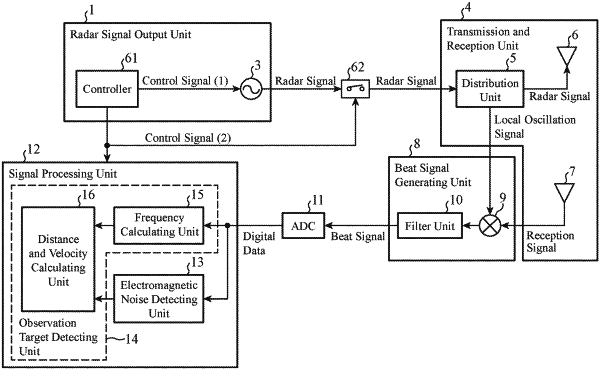| CPC G01S 13/931 (2013.01) [G01S 7/4056 (2013.01); G01S 2013/9318 (2020.01); G01S 2013/93185 (2020.01); G01S 2013/932 (2020.01)] | 10 Claims |

|
10. An in-vehicle device comprising a radar device for detecting an observation target,
wherein the radar device includes:
a first processing circuitry performing a first process of:
generating a beat signal when a frequency-modulated signal, whose frequency changes with passage of time, is intermittently and repeatedly transmitted as a radar signal and the radar signal reflected by an observation target is received as a reflection wave in a period when the radar signal is transmitted, the beat signal having a frequency that is a difference between a frequency of the radar signal that has been transmitted and a frequency of the reflection wave;
converting the beat signal generated into digital data and outputting the digital data;
detecting electromagnetic noise input using digital data in a period when no radar signal is transmitted, among the digital data output; and
detecting the observation target using digital data in the period when the radar signal has been transmitted, among the digital data output, and the electromagnetic noise detected
intermittently and repeatedly outputting a frequency-modulated signal whose frequency changes with passage of time as a radar signal; and
transmitting the radar signal output toward the observation target, receiving the radar signal reflected by the observation target as a reflection wave, and outputting each of the radar signal output and the reflection wave,
wherein the first process calculates each of a frequency of the electromagnetic noise input and a Doppler frequency that corresponds to a relative velocity with respect to a source of the electromagnetic noise using the digital data in the period when no radar signal is output, among the digital data output, and
the observation target detector includes:
a second processing circuitry performing a second process of:
calculating each of a beat frequency that corresponds to a distance to the observation target and a Doppler frequency that corresponds to a relative velocity with respect to the observation target using the digital data in the period when the radar signal is output among the digital data output; and
calculating each of the distance to the observation target and the relative velocity with respect to the observation target using the beat frequency calculated, the Doppler frequency calculated, the frequency of the electromagnetic noise calculated, and the Doppler frequency calculated.
|